Just as with most things in this life… the answer is Maybe!
I know! You wanted a simple answer to a simple question. Unfortunately, the answer to that question will entirely depend on your personal circumstances.
You see, for everyone, owning a meditation cushion will be helpful in so many ways. But, that wasn’t your question, was it? You asked if you NEED one.
Let’s first of all, look at why a meditation cushion is recommended.
Well, the human body is ‘bendy’ and it’s designed to move around, not sit still for long periods. But, if you’re going to practice meditation, you’re going to be in the same position for some time.

That means that you’re 100% reliant on what ever you’re sitting on. And, if you don’t have proper support, your legs, hips, spine, shoulders, and head are going to be misaligned. This can very quickly make you uncomfortable, in a many cases, it’ll be quite painful and occasionally damaging.
You can, to some extent make yourself slightly more comfortable by sitting on one, or two scatter cushions from the sofa (I did that for a while). It certainly helps, but the problem with things like this, is that the filling in a ‘normal’ cushion is usually soft and ‘springy’. Great for leaning against, not so good for sitting on.
If this is something you’ve tried, you’d have noticed that very quickly, you may as well be sitting on a blanket on the floor. The ‘fluffy’ filling compresses easily and doesn’t really give that much comfort, or support.
So, for many people, ‘nice to have’ can quickly become ‘need to have’.
If you’re someone who’s into Yoga, or is involved in one of the martial arts, there’s a good chance your joints will be flexible and supple. If you can keep your back straight and can sit comfortably on the floor… you don’t need a meditation cushion.
But, if you’re one of those people who’s joints aren’t so flexible. Or, if you just can’t get comfortable and you need something that supports you correctly, what are your options?
Free alternatives:

Contrary to popular belief, meditation doesn’t have to mean sitting cross-legged on the floor. You could just as easily sit on a chair, or a stool. As long as your back is straight (so no leaning against the back of the chair 🙂 ), the benefits of meditation are just as effective sitting in a chair, as sitting in the lotus position.
There are types of meditation, where lying flat on your bed is just as acceptable (the body scan, for example). Another idea I’ve heard of, is sitting on a large pet bed. So, there are options if you’re not ready to take the plunge yet.
But, let’s imagine that you’ve tried different things and you’re ready to make the leap.
It may be a good place to start, if we look at the different types of ‘sitting aids’ and what each of them helps with. Then, once you have that info, hopefully you’ll have an answer that works for you.
So, let’s get started…
To begin with, there are various types of sitting aid to chose from. Each one has it’s benefits and each one is helpful in different circumstances.
Chair/Stool based options:

Like I said earlier, you can just use an everyday dining room chair. It’ll probably be worth putting a cushion on the seat, because they’re not renowned for their comfort over long periods, but apart from that, it’ll work fine.
If you want to go a bit upmarket, you could look at a meditation bench. You can look at a full range on Amazon (click here if you’re in the UK) and they range from about $40-£100 (£30-£80). When using a bench, you’ll be sitting in the “Seiza” position. (kneeling, with your legs underneath and your bum on the seat)
A meditation bench is most suitable for people who prefer not to sit cross-legged. These are also great for people who maybe have less flexible joints, etc. These are great, but you’ll probably also need a zabuton (big, flat, cushioned mat), because otherwise, your knees will be resting on the floor.
Cushion based options:
This is where it can start to get complicated. There are so many options available, it really is a matter of choice here. The most common type of cushion is called a “Zafu“. Its basically a round cushion, usually filled with Buckwheat hulls, or Kapok. They come in various designs, but they’re all used the same way. An averagely priced Zafu will generally be around 30-40cms diameter and around 15-20cms high. Some are cylindrical, some look similar to a doughnut. But, like I said, there are a lot of different choices, so personal preference is the main deciding factor.
Zafus can vary quite dramatically in price. I’ve seen them for £30 and I’ve also seen them for over £1000. But, a higher cost doesn’t always mean a better quality product (although the cushion is usually bigger in the costlier range).
If you’re in the US, you can see the current range available on Amazon, by CLICKING HERE. In the UK?, CLICK HERE.
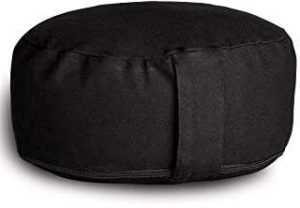
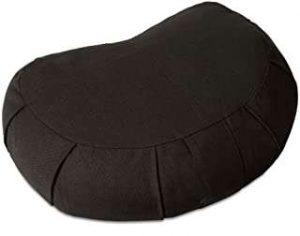
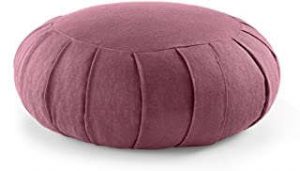
The biggest benefit of a Zafu, is they’re comfortable, whether you sitting on them cross-legged, or if you turn it on it’s side and sit in the Seiza position. They’re comfortable immediately, and for $40 (£30), you can’t really go wrong.
Blanket/mat based options:
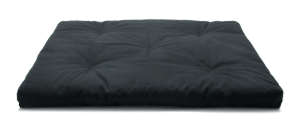
The last option is to just use a mat. Many people go with a normal Yoga mat. You can roll it up and take it anywhere fairly easily (Zafus are heavy for their size). Clearly there’s a difference in comfort level from either of the other options, but if you’re relatively young, with good joints, or you’ve been practicing meditation for a while, maybe this is the best option for you. If a Yoga mat hasn’t quite got the comfort you’re looking for, you could always try a Zabuton. Basically, it’s a thick, cushioned mat, usually around 2-3cms in height.
Again, in the US you can find a great selection on Amazon HERE and CLICK HERE if you’re in the UK.
Additional meditation comfort aids:
Even once you’ve bought your new Zafu, Zubaton, etc., you could still find your joints aching after a while (especially the hips). Some forms of Buddhist meditation would say you should sit with the ache. Experience it, without judgement. Some, would say you should mindfully move the affected joint and be aware of what is happening in the joint as it’s moving.
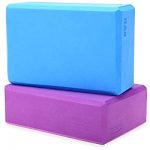
But, if you’re just starting with meditation and you just want to be comfortable, there’s one additional item that can help, a lot… Yoga Blocks.
They’re brick shaped, EVA blocks (many different sizes available), that you put under your knees. They’re malleable and they support your knees, so you don’t put excess stress on your hips.
For a list on Amazon on the US, CLICK HERE, In the UK, CLICK HERE.
So, there you have it. A selection of answers for you to choose form. Honestly, even if you didn’t need it, why wouldn’t you?
Do you have experience with any of these options? Why not share your experience in the comments 🙂
[convertkit form=1596322]


2 Replies